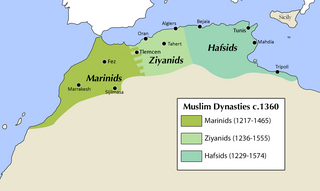
Much of the history of Algeria has taken place on the fertile coastal plain of North Africa, which is often called the Maghreb. North Africa served as a transit region for people moving towards Europe or the Middle East, thus, the region's inhabitants have been influenced by populations from other areas, including the Carthaginians, Romans, and Vandals. The region was conquered by the Muslims in the early 8th century AD, but broke off from the Umayyad Caliphate after the Berber Revolt of 740. During the Ottoman period, Algeria became an important state in the Mediterranean sea which led to many naval conflicts. The last significant events in the country's recent history have been the Algerian War and Algerian Civil War.
The Zayyanid dynasty or Abd al-Wadids was a Berber Zenata dynasty that ruled the Kingdom of Tlemcen, mainly in modern Algeria centered on the town of Tlemcen in northwest Algeria. The Zayyanid dynasty's rule lasted from 1235 to 1557.

The Hafsids were a Sunni Muslim dynasty of Berber descent who ruled Ifriqiya from 1229 to 1574.

The Marinid dynasty was a Berber Muslim dynasty that controlled present-day Morocco from the mid-13th to the 15th century and intermittently controlled other parts of North Africa and of the southern Iberian Peninsula (Spain) around Gibraltar. It was named after the Banu Marin, a Zenata Berber tribe. It ruled the Marinid sultanate, founded by Abd al-Haqq I.

Abu Al-Hasan 'Ali ibn 'Othman, was a sultan of the Marinid dynasty who reigned in Morocco between 1331 and 1348. In 1333 he captured Gibraltar from the Castilians, although a later attempt to take Tarifa in 1339 ended in fiasco. In North Africa he extended his rule over Tlemcen and Hafsid Ifriqiya, which together covered the north of what is now Algeria and Tunisia. Under him the Marinid realms in the Maghreb briefly covered an area that rivalled that of the preceding Almohad Caliphate. However, he was forced to retreat due to a revolt of the Arab tribes, was shipwrecked, and lost many of his supporters. His son Abu Inan Faris seized power in Fez. Abu Al-Hasan died in exile in the High Atlas mountains.
Abu Sa'id Uthman II was the 9th Marinid sultan of Morocco, reigning from 1310 to 1331. A younger son of Abu Yusuf Yaqub ibn Abd al-Haqq, Abū Sa'īd 'Uthmān succeeded his nephew Abū al-Rabï' Sulaymān as Sultan of Morocco in November 1310, at the age of 33.
Abu Thabit 'Amir ibn Yusuf was a Marinid ruler of Morocco for around a year. Son or grandson of Abu Yaqub Yusuf, whom he succeeded in 1307.

Abu Yaqub Yusuf an-Nasr was a Marinid ruler of Morocco. He was the son of Abu Yusuf Ya'qub, whom he succeeded in 1286. His mother was a sharifa, Lalla Oum'el'Iz bint Mohammed al-Alaoui. He was assassinated in 1307.

Turkey–Morocco relations are the foreign relations between Morocco and Turkey, and spanned a period of several centuries, from the early 16th century when the Ottoman Empire neighbored Morocco to until modern times.
Abu al-Hasan as-Said al-Mutadid was an Almohad caliph who reigned from 1242 until his death. He was a son of Idris al-Ma'mun.

The Kingdom of Tlemcen or Zayyanid Kingdom of Tlemcen was a kingdom ruled by the Berber Zayyanid dynasty in what is now the northwest of Algeria. Its territory stretched from Tlemcen to the Chelif bend and Algiers, and at its zenith reached Sijilmasa and the Moulouya River in the west, Tuat to the south and the Soummam in the east.
Abu Zayyan (I) Muhammad ibn Abi Said Uthman ibn Yaghmurasan, known as Abu Zayyan I, was the third Zayyanid Sultan of the Kingdom of Tlemcen. He succeeded his father Abu Said Uthman I on June 6, 1304.
Musa ibn Abī Saʿīd ʿUt̲h̲mān ibn Yag̲h̲murāsan, known as Abu Hammu I, was the fourth Zayyanid Sultan of the Kingdom of Tlemcen. He was proclaimed on 21 S̲h̲awwāl 707/15 April 1308 after the death of his brother Abu-I Zayyan I, which took place in 1308, ruling until 1318, the year of his assassination at the hands of his son Abu Tashufin I, who ascended the throne.
Abu Said Uthman I, or "Othmane Ibn Yaghmoracen", or in Algerian arabic, ruled the Zenata Berber Kingdom of Tlemcen in Medieval Algeria from 1283 to 1303.
Abu Tashufin I, was the 5th Sultan of the Zayyanid dynasty ruling the Kingdom of Tlemcen, in medieval Algeria.
The siege of Tlemcen from 1299 to 1307 designates all of the operations undertaken by the army of the Marinid sultan, Abu Yaqub Yusuf an-Nasr to seize the city of Tlemcen, the capital of the Zayyanid Kingdom, during the conflict between the Kingdom of Tlemcen and the Marinids. The siege was lifted following the assassination of the Marinid Sultan.

The Battle of Moulouya took place in May 1692 at a ford on the Moulouya river in Morocco. It was fought between the armies of the Alawi sultan Moulay Ismail and those of the Dey of Algiers Hadj Chabane.
The Campaign of Tlemcen or Tlemcen campaign was a military operation led by the Saadians of Mohammed ash-Sheikh against Tlemcen in 1557, then under the domination of the Regency of Algiers, a vassal state of the Ottoman Empire. Mohammed ash-Sheikh, who wanted to conquer Algeria, occupied the city but failed to seize the Mechouar Palace, which was defended by a garrison of 500 men under the command of Caïd Saffa.
The Zayyanid capture of Fez took place in 1423 and was led by Abu Malik Abdulwahid, the ruler of Tlemcen. He succeeded in briefly installing his own client king on the Marinid throne in Fez, before being defeated the following year by the Hafsid sultan of Tunis.

The Zayyanid-Almohad wars (1236–1248), also known as the Tlemcen-Almohad wars, were a series of conflicts that occurred between the Zayyanid dynasty, rulers of the Kingdom of Tlemcen in present-day Algeria, and the Almohad Caliphate, a North African Berber-Muslim empire that existed from the 12th to the 13th centuries. These wars took place during the Almohad period and were primarily fought over territorial control and influence in the Maghreb region of North Africa.








